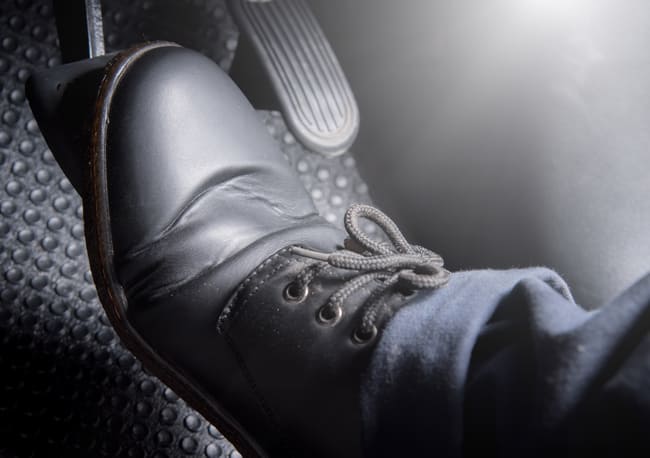
As important as the engine is to your car, your braking system is just as important. Because without a functioning braking system in the car, you would not be able to stop your car at the latest at your destination. Since this vehicle system should always work perfectly and needs regular maintenance, as a driver you should understand how it works. This is the only way for you to be able to identify imminent defects in your car's brake system at an early stage and have them rectified in good time by a specialist workshop. In this way you ensure that you are always safe on the road.
Contents
But how does your car's brake system work?

First of all, you have to consider what the purpose of your braking system is: to slow down your vehicle, i.e. to brake. The actual braking devices brake the individual wheels of your vehicle. For this reason, they can be found on almost all models in the wheel area. This also makes it possible to brake individual wheels more or less. The engineers make use of this option when developing the electronic stability program (ESP). However, there are still more components involved. In the following sections, we will first explain the general structure of your braking system.
Today it is a requirement that every car has two brake circuits. Ultimately, this can slow down both your front axle and your rear axle. While in recent decades disc brakes were usually only installed at the front and drum brakes at the rear, disc brakes are almost exclusively found in modern cars. The most important components are the brake pedal, brake hoses and brake fluid, brake pads, brake discs, brake calipers, as well as a master cylinder and four wheel brake cylinders. Most cars also have a brake booster installed. In addition, the anti-lock braking system (ABS) also counts as a safety system for the brake, just like your parking brake. Knowing these components is enough to understand the explanation of your car's braking system.
What happens when you step on your brake pedal?

By depressing the brake pedal with your foot, this force is used to transfer it to the brake master cylinder. This hydraulic cylinder contains the brake fluid with which this hydraulic system can be operated. The resulting pressure can then be transferred to the wheel brake cylinders via the brake hoses. To ensure safety, the pressure is transmitted through the brake fluid with the help of two hydraulic circuits. In this way it can be ensured that in the event of damage not all brakes fail at the same time. When braking, the driver is supported by the so-called brake booster, which is able to increase the force by stepping on the brake pedal up to seven times.
The brake force is then transmitted through the wheel brake cylinder to the brake calipers on which the brake pads are mounted. The calipers press the brake pads against the brake discs, which are connected to the spinning wheels. This creates a correspondingly high frictional force, which is able to slow down your individual wheels. Depending on the structure of the brake system, there are brake systems with 4 pistons as well as brake systems with 8 pistons.
In an electric or hybrid vehicle, the braking system is equipped with a recuperation system. This is colloquially referred to as a regenerative brake. This serves as a kind of energy recovery, because it is able to convert the kinetic energy into electrical energy when braking. It is no longer just lost as heat, but can be used again when you accelerate again. This allows it, in particular, when driving in town, when braking and accelerating relatively frequently.
Problems and defects of your brake system

Of course, there can also be defects and problems with the brake system of your car. Ultimately, every single component of the system can fail. However, there are some classic wearing parts that should/have to be replaced regularly anyway.

This includes the brake pads, brake discs, brake fluid and brake hoses. Their maintenance intervals are determined in such a way that these components should not cause any problems when they are replaced at regular intervals.
The situation is somewhat different with the other brake system components. Although these are not completely renewed after a certain period of time, they are still subject to wear and tear. For example, the individual brake cylinders can leak or a brake caliper can jam. The latter means that individual wheels are permanently braked or that your brakes can no longer brake the corresponding wheel at all. Such a defect in your brake system can quickly become life-threatening and also lead to extreme tire wear. In such a case, the caliper urgently needs to be repaired or replaced. Leaks, on the other hand, can often be repaired by changing the seals. With this type of defect, the braking efficiency decreases more and more and the brake fluid level keeps falling. If this falls below the minimum level, your brake system in the car will fail completely.
It is also problematic if moisture or air gets into the brake system. This means that the brake fluid, which can become very hot when braking, may boil. This causes air bubbles to form in the braking system, causing your brakes to lose efficiency or fail completely.
Conclusion
The brakes belong to the car like holy water belongs to the Catholic Church. Nowadays it is inconceivable to even think about building a vehicle without brakes. Because without a braking system, you wouldn't be able to drive your vehicle as dynamically as you would like. You now also know the most important components and have understood which defects can occur. Take care of your brakes and you will always enjoy a very safe journey!
A tip from CarTipsandmore: There are various ways to permanently reduce brake wear. This includes, for example, preferring to roll out and taking your foot off the accelerator sooner. With this anticipatory driving style and by shifting down, you have to use your brakes less often. Clearing out and thus reducing the vehicle weight also reduces the braking load. In addition, regular maintenance can prevent major defects from occurring, which can quickly become expensive.
